Peripheral Arterial Disease – Redefining PAD Treatment Strategies
– Market Insight, Clinical trial, Product Analysis, Patent Analysis, Competitive Analysis and Market Forecast – 2024-2034
Peripheral Arterial Disease (PAD), also known as Peripheral Vascular Disease, is a common circulatory problem characterized by the narrowing of arteries, primarily in the legs. This condition results from the accumulation of plaque—comprising fats, cholesterol, and other substances—on the arterial walls, leading to reduced blood flow to the extremities.
Pathophysiology
PAD primarily affects the arteries in the legs, which carry oxygen-rich blood from the heart to the limbs. Plaque buildup, or atherosclerosis, progressively narrows these arteries, limiting blood flow. The plaque has a hard exterior and a soft interior, which can rupture, causing blood clots that further obstruct the arteries.
Symptoms
Many individuals with PAD may be asymptomatic, but common symptoms include:
Diagnosis
To diagnose PAD, healthcare providers use several methods:
Treatment Approaches
Effective management of PAD often begins with lifestyle changes:
Various medications can help manage PAD:
For severe cases of PAD, medical procedures might be necessary:
Conclusion
The future of Peripheral Arterial Disease (PAD) treatment is promising, with significant advancements on the horizon. Emerging therapies such as gene and cell treatments aim to promote new blood vessel formation and repair damaged tissues. Advanced pharmacological treatments are being developed to target inflammation and endothelial dysfunction more effectively. Minimally invasive procedures like drug-coated balloons and bioresorbable stents are enhancing the success of angioplasty, while personalized medicine, based on genetic profiling, is paving the way for tailored treatment plans. Additionally, wearable technology and telemedicine are improving patient monitoring and follow-up care, offering hope for better management and improved quality of life for PAD patients.
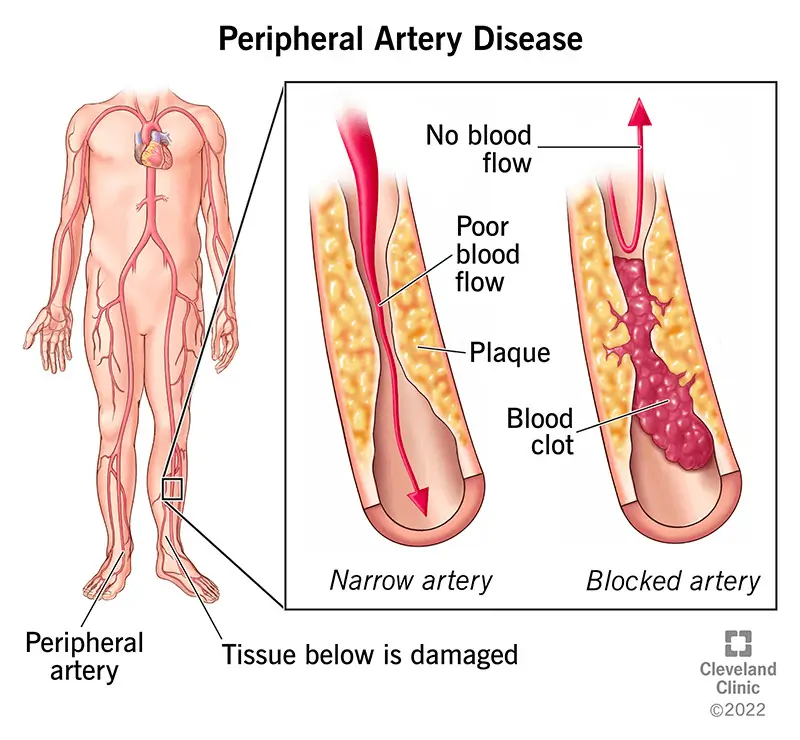
Figure 1 Credits: >>
To maintain competitiveness in the Peripheral Arterial Disease (PAD) sector in the short to mid-long term, it is crucial to understand the entirety of the PAD developmental pipeline. This includes staying updated on the evolving treatment landscape, competitor strategies, and upcoming advancements.
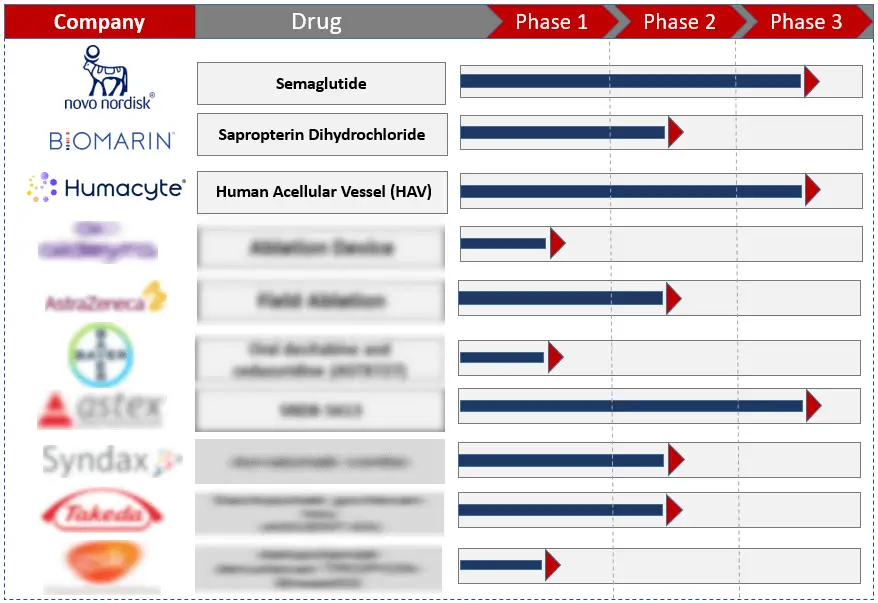
Figure 2 Pipeline Candidate
Profiles of key stakeholders advancing Peripheral Arterial Disease (PAD) solutions offer valuable insights into their financial standing, product portfolios, and recent innovations within the sector.
This report examines patents associated with Peripheral Arterial Disease (PAD), highlighting notable innovations and emphasizing opportunities for improvement or collaboration within the field.
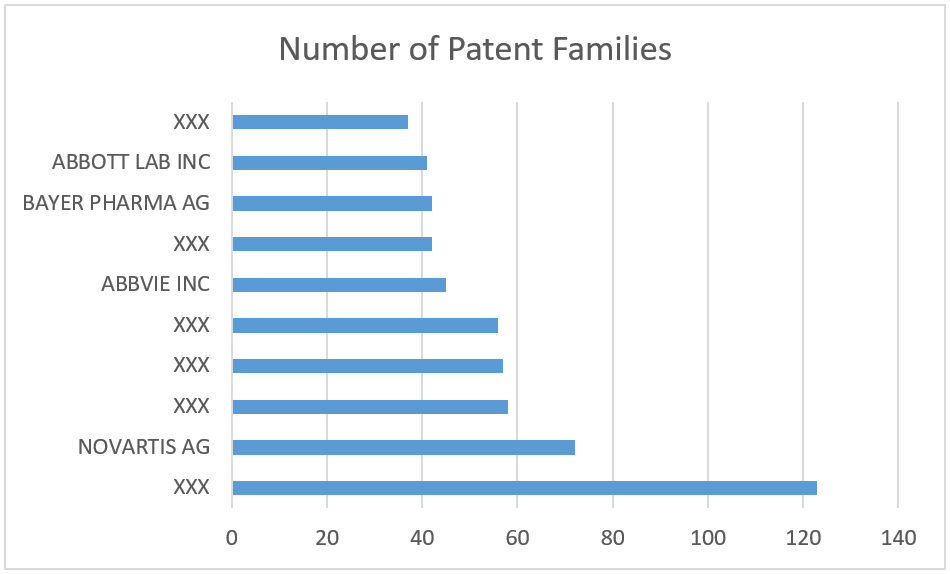
Figure 3 Top applicants in PAD domain as of May 2024
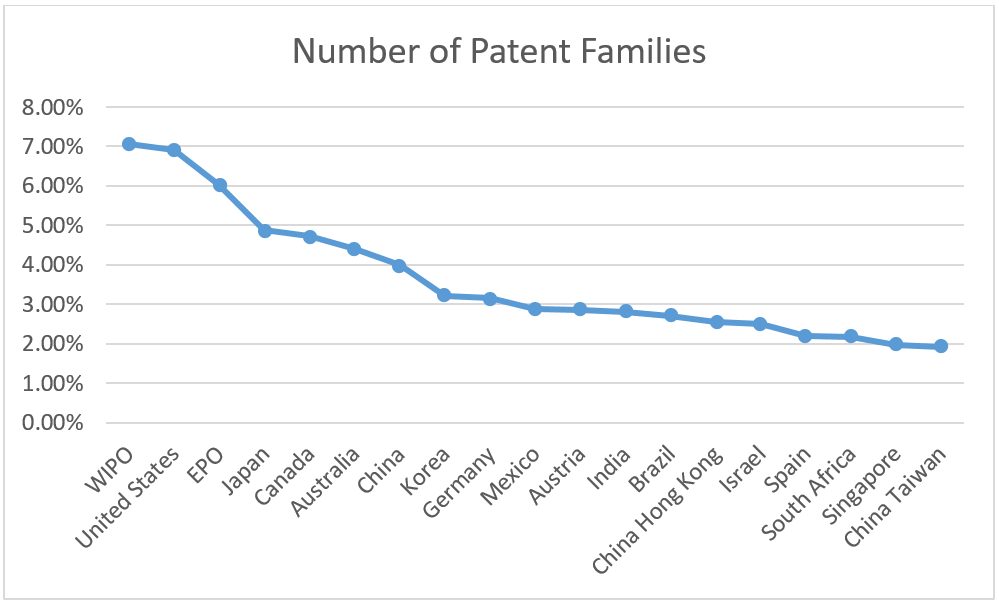
Figure 4 Popular market analysis
This report on Peripheral Arterial Disease (PAD) anticipates upcoming advancements, outlines pathways for expansion, and provides critical insights into market dynamics, including scale, revenue forecasts, and growth opportunities.
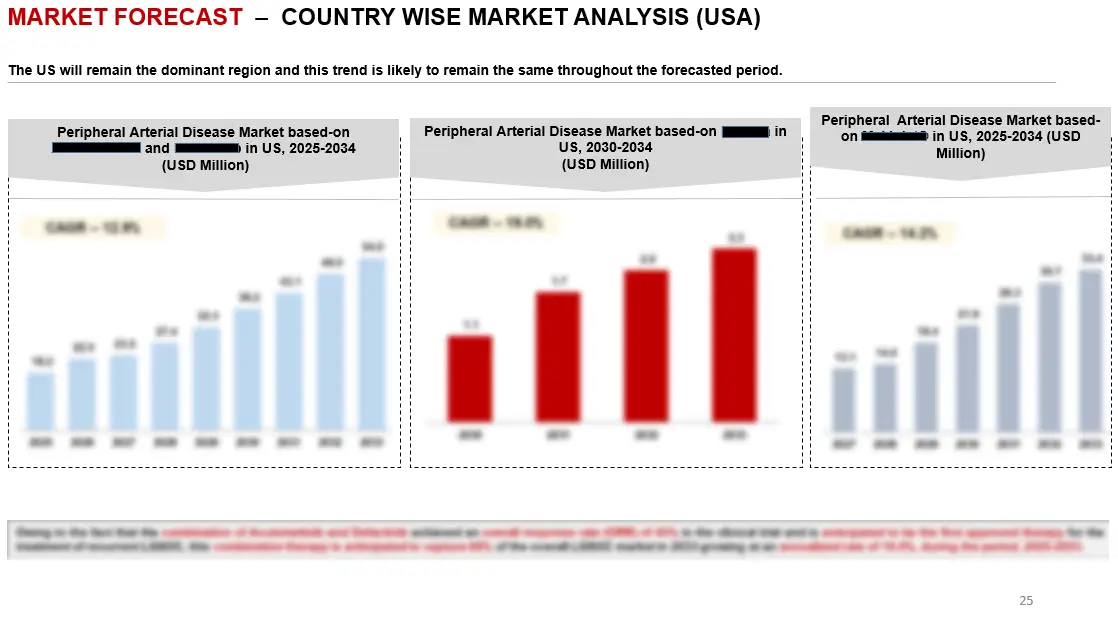
Figure 5 Region-wise market forecast
The competitive landscape section offers a comprehensive analysis of key market players in the Peripheral Arterial Disease (PAD) domain, including their market shares and concise profiles detailing strengths, weaknesses, and strategies. Additionally, it provides competitive benchmarking services for comparative performance insights and industry standards.
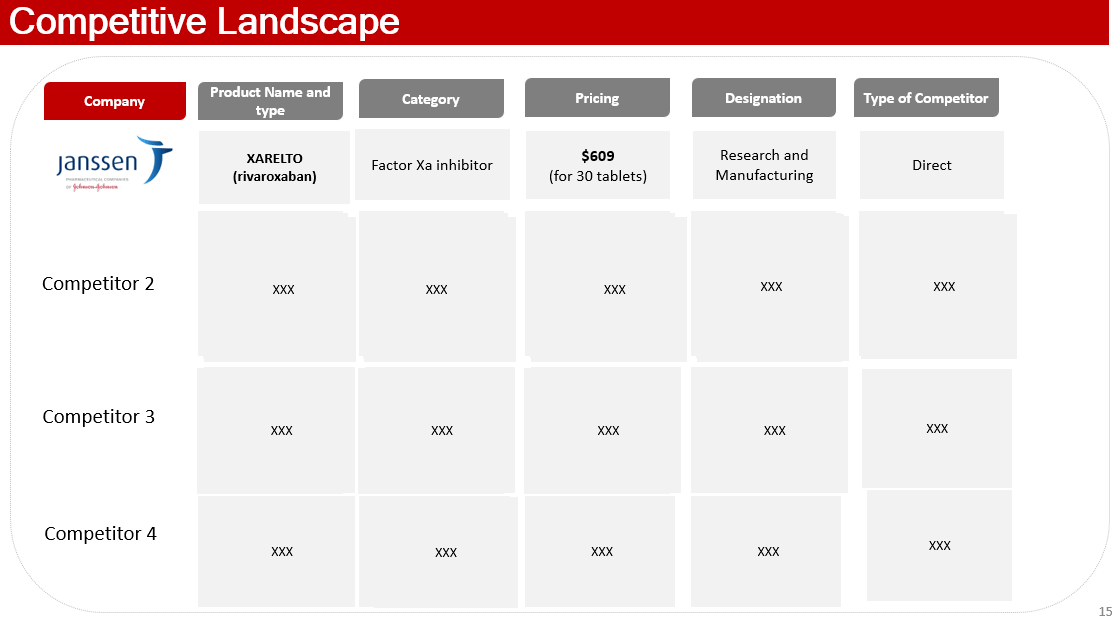
In order to give the most precise estimations and forecasts, Wissen Research uses an extensive and iterative research approach that is focused on reducing deviation. The company blends top-down and bottom-up methodologies for market segmentation and quantitative estimation. In addition, data triangulation, which examines the market from three separate angles, is a recurrent topic present in all of our research studies. Important components of the approach used for all of our studies include the following:
Preliminary data mining
On a wide scale, unprocessed market data is collected. Continuous data filtering makes sure that only verified and authenticated sources are taken into account. Additionally, data is extracted from a wide range of reports in our repository and from a number of reputable premium databases. We gather information from raw material suppliers, distributors, and purchasers to help with this since understanding the entire value chain is crucial for a thorough understanding of the market.
Surveys, technical symposia, and trade magazines are used to gather information on technical concerns and trends. Technical information focusing on white space and freedom of movement is also obtained from an intellectual property standpoint. Additionally, information on the industry’s drivers, constraints, and pricing patterns is obtained. As a result, a variety of original data are included in the material that is then cross-validated and certified with published sources.
Statistical model
We use simulation models to generate our market projections and estimates. Every study receives a special model that is tailored to it. Data for market dynamics, the technology environment, application development, and pricing patterns are gathered and supplied into the model all at once for analysis. The relative relevance of these factors is investigated, and their impact on the forecast period is assessed, using correlation, regression, and time series analysis. The process of market forecasting combines technological analysis with economic strategies, practical business acumen, and subject expertise.
Econometric models are frequently used for short-term forecasting, but technology market models are typically employed for long-term forecasting. These are based on a confluence of the business environment, regulatory environment, economic projection, and technical landscape. In order to develop global estimates, it is preferable to estimate markets from the bottom up by integrating data from key regional markets. This is required to ensure accuracy and a complete comprehension of the subject. Among the variables taken into account for forecasting are:
Regulations and anticipated developments
We give these criteria weights and use weighted average analysis to assess their market influence in order to calculate the anticipated market growth rate.
Data Collection Matrix:
Primary research | Secondary research |
· Manufacturers · Technology distributors and wholesalers · End-user surveys · Consumer surveys | · Company reports and publications · Government publications · Independent investigations · Economic and demographic data · Online searches · Research reviews · Reference customers |
1.1 Overview of Peripheral Arterial Disease (PAD)
1.1.1 Definition and Classification of PAD
1.1.2 Scope and Applications of PAD Research
1.1.3 Benefits and Current State of PAD Therapies
1.2 Key Findings
1.3 Market Insights and Highlights
1.4 Research Background
1.5 Scope and Methodology
2. Technological Landscape of PAD
2.1 Types of Peripheral Arterial Disease (PAD)
2.1.1 Classification by Affected Arteries
2.1.2 Classification by Severity (Stages of PAD)
2.2 Pathophysiology and Characteristics
2.3 Emerging Technologies in PAD Diagnosis and Treatment
3. Market Dynamics
3.1 Market Drivers and Challenges
3.2 Regulatory Landscape in PAD Research
4. Patent Analysis
4.1 Top Assignees in PAD Technology
4.2 Geography Focus of Top Assignees
4.3 Legal Status of PAD Patents
4.4 Assignee Segmentation
4.5 Network Analysis of Top Collaborating Entities in PAD Patent Applications
4.6 Technology Evolution in PAD
4.7 Key Patents in PAD
4.8 Patent Trends and Innovations
4.9 Key Players and Patent Portfolio Analysis
5. Clinical Trial Analysis
5.1 Overview of PAD Clinical Trials
5.2 Analysis by Trial Registration Year
5.3 Analysis by Phase of Development
5.4 Analysis by Number of Patients Enrolled
5.5 Analysis by Status of Trial
5.6 Analysis by Study Design
5.7 Analysis by Intervention Type
5.8 Analysis by Geography
5.9 Analysis by Key Sponsors/Collaborators
6. Market Forecast (2024-2034)
6.1 Methodology
6.2 Assumptions
6.3 Projected Growth of PAD Market (2024-2034)
6.3.1 Global PAD Market (2024-2034)
6.3.1.1 By Treatment
6.3.1.1.1 Lifestyle Modifications and Exercise Therapy
6.3.1.1.2 Pharmacotherapy
6.3.1.1.3 Revascularization Procedures
6.3.1.2 By Route of Administration
6.3.1.2.1 Oral Medications
6.3.1.2.2 Injectable Therapies
6.3 1.2.3 Catheter-Based Interventions
6.3.2 Market Value Forecast in North America, Europe, and Asia Pacific (2024-2034)
6.3.2.1 By Treatment
6.3.2.1.1 Lifestyle Modifications and Exercise Therapy
6.3.2.1.2 Pharmacotherapy
6.3.2.1.3 Revascularization Procedures
6.3.2.2 By Route of Administration
6.3.2.2.1 Oral Medications
6.3.2.2.2 Injectable Therapies
6.3.2.2.3 Catheter-Based Interventions
7. Competitive Landscape
7.1 Benchmarking Parameters
7.2 Scoring of Different Companies
7.3 Top Company Profiles
7.3.1 Abbott Laboratories
7.3.2 NovoNordisk
7.3.3 Boston Scientific Corporation
7.3.4 Medtronic Plc
7.3.5 Biomarin
7.3.6 Humacyte
7.3.7 Cook Medical
7.3.8 Becton, Dickinson and Company
7.3.9 Terumo Corporation
7.3.10 Cardinal Health
7.3.11 Koninklijke Philips N.V.
7.3.12 Johnson & Johnson
7.3.13 Others
7.4 Product Portfolio Analysis
7.5 Recent Developments and Strategies
8. Future Outlook and Market Opportunities
8.1 Technological Advancements in PAD Research
8.2 Unmet Needs and Potential Market Gaps
9. Conclusion
10. Appendix
10.1 Glossary of Terms
10.2 List of Abbreviations
S.no | Key Highlights of Report | |
1. | Patent Analysis | · Top Assignee · Geography focus of top Assignees · Assignee Segmentation · Technology Evolution · Key Patents · Application and Issued Trend · Key technology |
2. | Market Analysis | · Current Treatment Options · Emerging Therapies and Research Developments (by product analysis and scientific analysis) · Strategic activities · Therapeutic activity of drugs · Company portfolio · Detailed profiles of the key players that are engaged in the development of approved drugs |
3. | Clinical Trials | · Analysis of clinical trial through graphical representation · Coverage of treatments from pre-clinical phases till commercialization (also including terminated and completed studies) |
4. | Forecast | · Detailed comprehension of the historic, current and forecasted trend of market by analysis of impact of these treatments on the market |
5. | Opportunity Analysis | · Technology evolution based on problem solution · Potential licensees · Treatment trends · Unmet needs · SWOT · Drivers and barriers |
6. | KOLs | · A detailed analysis and identification of the Key Opinion Leaders (KOLs), shortlisted based on their contributions |
LIST OF FIGURES
Figure number | Description |
Figure 1 | Terminology of Peripheral Arterial Disease (PAD) Over The Years |
Figure 2 | Peripheral Arterial Disease (PAD)– History and Present |
Figure 3 | Projection of Peripheral Arterial Disease (PAD) till 2034 in different geographies |
Figure 4 | Technology Categorization For Peripheral Arterial Disease (PAD) therapies |
Figure 5 | Recent Technology Trends in Peripheral Arterial Disease (PAD) therapies |
Figure 6 | Technology Evolution in Peripheral Arterial Disease (PAD) therapies |
Figure 7 | Geographical Distribution of Patents of Top Assignees |
Figure 8 | Assignee Segmentation (Companies) |
Figure 9 | Assignee Segmentation (Educational Establishment) |
Figure 10 | Patent Based Key Insights Of xx |
Figure 11 | Patent Based Key insights of xx |
Figure 12 | Patent Based Key insights of xx |
Figure 13 | Geographic Distribution of the Universities/Research Organizations Filling Patents On Various Technology advancements |
Figure 14 | Key Summary Regarding the Patent Filing On Peripheral Arterial Disease (PAD) |
Figure 15 | Product Pipeline of Different therapeutic approaches with Companies Name |
Figure 16 | Portfolio for Government Approved Hepatic medications |
Figure 17 | Key Growth Drivers for Peripheral Arterial Disease (PAD) Market |
Figure 18 | Restraints for Peripheral Arterial Disease (PAD) Market |
Figure 19 | xx Portfolio (Top Player) |
Figure 20 | xx Portfolio (Top Player) |
Figure 21 | xx Portfolio (Top Player) |
Figure 23 | xx Portfolio (Top Player) |
Figure 24 | xx Portfolio (Top Player) |
Figure 25 | xx Portfolio (Start-up) |
Figure 26 | xx Portfolio (Start-up) |
Figure 27 | xx Portfolio (Start-up) |
Figure 28 | Strategic Activities Including Collaboration, Partnerships and Acquisitions |
Figure 29 | Research Methodology for Patent, Selection and Analysis |
LIST OF GRAPHS
Graph number |
Description |
Graph 1 | Problem Solution Analysis |
Graph 2 | Top Assignees in Peripheral Arterial Disease (PAD) treatment therapy |
Graph 3 | Technology Focus of Top Assignees (IPC-CPC Classes) |
Graph 4 | Top Countries of Origin of Patents |
Graph 5 | New entrants in PAD field |
Graph 7 | Legal Status |
Graph 8 | Most Cited Patents |
Graph 9 | Patents with Largest Invention Families |
Graph 10 | Most Claim-Heavy Patents |
Graph 11 | Filing Trends |
Graph 12 | Weighted Scores for Top xx Players According to Benchmarking Criteria |
Graph 13 | Peripheral Arterial Disease (PAD) (CAGR: 2024-2034) |
Graph 14 | Peripheral Arterial Disease (PAD) Market Share: Distribution by Key Geographical Area, 2024-2034 |
LIST OF TABLES
Table number | Description |
Table 1 | Parameters included and excluded for conducting the analysis |
Table 2 | Technology Classes with Definitions |
Table 3 | Patent Litigation |
Table 4 | Highest Market Valued Patents |
Table 5 | SWOT Analysis of Top 3 Players |
Table 6 | Parameters and their score for Benchmarking |
Table 7 | Weighted scores for top 5 players according to benchmarking criteria |
© Copyright 2024 – Wissen Research All Rights Reserved.